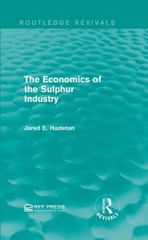Question
Suppose the state wants to try and reduce traffic congestion by imposing tolls on drivers. To figure out the socially optimal toll, make the following
Suppose the state wants to try and reduce traffic congestion by imposing tolls on drivers. To figure out the socially optimal toll, make the following assumptions:
The value of a driver's time not spent in a car is $30/hour. The number of cars on the road is denoted N, and the overall traffic speed in miles per hour is denoted S. When there are less than 5 cars on the road (N<5), traffic moves at 60 MPH. When there are 5 or more cars (N5), the speed is S=300/N.
a. What is the average cost per mile (AC), in terms of the number of cars on the road? Calculate this for N<5 and N5. Graph the AC curve, with N on the x-axis, $ on the y-axis.
[One can show that for N<5, the marginal cost MC=AC. For N5, MC=N/5. Graph this on the same graph as part a.]
b. During the evening, the marginal benefit for drivers is MB=6-(N/10).
i. What is the market equilibrium number of drivers in the evening?
ii. What is the socially efficient equilibrium number of drivers in the evening?
iii. What, if any, is the optimal toll level?
Step by Step Solution
There are 3 Steps involved in it
Step: 1

Get Instant Access to Expert-Tailored Solutions
See step-by-step solutions with expert insights and AI powered tools for academic success
Step: 2

Step: 3

Ace Your Homework with AI
Get the answers you need in no time with our AI-driven, step-by-step assistance
Get Started


